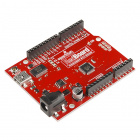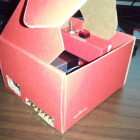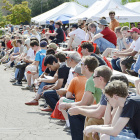Snobbotics
Member Since: March 26, 2011
Country: United States
-
What tube size can be used with this product?
-
I'd love to see a comparison between this and the Wild Thumper chassis. Anyone else interested in seeing a face off? It'd be cool to see how each one handled the same terrain, turning, pushing, speed, mechanical customization, etc.
-
Are these bits the same size as SFE's other screw driver [ https://www.sparkfun.com/products/10865 ] ?
-
I absolutely love this pen. Too bad I can't buy it from SFE, but I just found it at Allied Electronics: http://www.alliedelec.com/search/productdetail.aspx?SKU=70177953
If you guys buy all of them before I can place my order, may the back-EMF of 1000 motors attack your motor controllers!
-
Hmm... on this product, it says it replaces ROB-11057, but when you click on the link, it brings up this exact page.
-
Passive filters: In a high pass filter, the capacitor takes the "high road" In a low pass filter, the capacitor takes the "low road"
-
IC Packages: IC chips n DIP is awesome Soldering SOICs will make you stoic (unless you've watched SFE soldering tutorials)
-
Current, Voltage, Resistance, Inductance, and Capacitance
Electrons are like cars, traveling along a road called a conductor. The road starts at a car dealership and ends at a recycling center. Good roads/conductors have many lanes to travel on. Each car/electron perfectly tailgates the electron in front of them, and there is no extra space on each lane of the road. Current is the rate at which cars pass a given mile-marker with respect to time. Because every electron/car is tailgating the next, all electrons move at the same speed, at the same time (unless in a dealership). The quality of the road (ice, dirt, gravel, pavement) will determine how easy it is for cars to drive on it, and is called resistance. Voltage is the difference between the number of cars at the dealership and the number of cars at the recycling center. If there are more cars at the dealership than there are at the recycling center, cars will drive from the dealership, through your circuit (hopefully) and into the recycling center. If there's a short (a direct connection between the dealership and the recycling center), the new cars at the dealership will drive right into the car smasher! The ratio of voltage to resistance determines the current on the road. If there are tons of Batmobiles and F350s on the lot and the Recycling center is empty, there's gonna be a current! Lots of cars to sell means more current. Terrible roads means less current. The speed of the electrons is determined by the wind speed and direction near the road. Wind conditions are called inductance. The current of the cars will generate its own wind force called flux, which will allow the cars to speed up, since the wind will travel in the same direction. If the resistance of the road increases or the voltage decreases, the moving air/flux will help propel the cars forward, resisting a change in current. Lastly, there are multiple car dealership-middle-men along the way to the recycling center. Cars sold at the main dealership are sold, drive, and then traded in and bought from the mini dealerships along the way until reaching the recycling center. Each mini dealership has an input and an output, and can hold a few cars (not as many as the main dealership). If the voltage of the main dealership changes and as a result, sells more cars, the mini dealerships have to buy those cars before they can sell more as well. This delay to change in voltage is called capacitance.
-
Wow. You did a much better job with a box than I did. This last independence day, I built my third wireless fireworks igniter. You are right about the thicker nichrome working better. The way I did it was with 22 gauge wire coiled about a quarter inch in diameter. I can put the fuse right inside the coil and it works every time. One more thing you should add: a car horn alarm system. Sweet launcher Zinefer!
-
When it says, 8:00 am – Doors open to teams, I didn't think there were any buildings near the raceway.


























